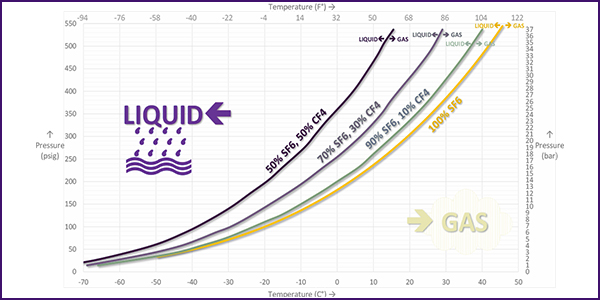[EDITOR’S NOTE: This story originally contained numerous factual inaccuracies that have since been corrected as of Dec. 2, 2020. These included referring to sulfur hexafluoride (SF6) as “sodium hexafluoride”; stating that mixed-gas breakers must be operated at a higher pressure than those using pure SF6; and stating that NERC recommended utilities switch to mixed-gas breakers (NERC cannot recommend that entities replace certain bulk power equipment with another type of equipment). ERO Insider apologizes for the errors.]
A safety mechanism present in many commonly used circuit breakers may pose an unexpected risk to the North American electric grid during periods of severe cold weather, according to a “Lessons Learned” notice posted by NERC on Thursday.
The “Cold Weather Operation of SF6 Circuit Breakers” paper stems from an investigation of the severe cold weather event of Jan. 29-30, 2019, in the Upper Midwest, when temperatures plunged below -30 degrees Fahrenheit in some areas covered by the report. During the event an unusual behavior pattern emerged on the system of two “Upper Midwest utilities”: Their sulfur hexafluoride (SF6) circuit breakers hit their critical pressure levels, causing them to auto-open or have their tripping operations blocked.
A subsequent investigation by Midwest Reliability Organization’s Protective Relay Subgroup found that 80 SF6 breakers operated by six registered entities in the region had exhibited such behavior. No outages were directly attributed to the circuit breakers’ pressure response, but the team warned that such actions could cause concern if they became widespread.
This was not the only unexpected impact to the bulk power system during the cold weather event; a number of wind generation cut-outs occurred in the region around the same time, after reaching their own temperature limits, though this was not identified as a contributor to the breaker lockouts. (See MISO Continues Honing Wind Forecasts.)
No Accounting for Widespread Breaker Failures
The auto-open and trip-blocking behavior was not a concern for the team itself: Auto-opening is understood to not only be normal, but desirable. But because SF6 gas must be above a certain pressure for the breakers’ tripping functions to work, equipment that nears this point may be unreliable.
Entities therefore prefer to either auto-open them or “block the trip and rely on a breaker failure relay to open all adjacent (or remote) breakers in the event of a fault.” But when a large number of breakers in an area enter a low-pressure state and become inoperable, their collective response can “[weaken] the overall topology of the system and … result in more facilities being removed from service to clear a fault.” In addition, entities’ real-time contingency analysis (RTCA) studies may no longer be accurate, increasing the level of uncertainty in the system.
The report notes that utilities in areas where extremely low temperatures are a regular occurrence take this into account in their system planning and prevent widespread low-pressure faults by installing breakers that use a mixture of SF6 and tetrafluoromethane (CF4) or nitrogen. SF6-CF4 mixtures remain gaseous at much lower temperatures than pure SF6.
The downside of mixed-gas breakers is that they are more expensive are require more equipment to handle the mixture than breakers using pure SF6. As a result, entities in areas where extremely low temperatures are less common will add heating elements to SF6 breakers to keep their temperature and pressure in safe operating range.
This approach carries its own risk, however, because inoperative heaters — which were found in 70% of the breakers affected by cold weather event — are obviously of no use. Even heaters that are working properly can still be overwhelmed if temperatures fall low enough and strong winds in the region further hamper the performance of the working heaters.
Need for Heaters a ‘Key Disadvantage’
In the report’s conclusion, NERC stressed that the need for heaters is a “key disadvantage of using … SF6 [breakers] in cold weather climes.”
If utilities in areas that can get very cold choose to keep using pure SF6 breakers, it is imperative that they implement proper safeguards against cold weather pressure drops, the report says. These measures may include maintenance and inspection of tank heaters before the onset of cold weather and installation of any temporary thermal insulation that may be necessary during the winter months.
Even if such precautions are taken, entities should expect that some insulation and heating elements will fail and lead to low-pressure cut-outs among the breaker fleet. Sensors should be installed to warn operations staff when heaters have failed so they can schedule proactive maintenance or at least prepare for pressure failures. Contingency models should also be updated to include multiple critical pressure faults so staff can be prepared for the worst-case scenario.




